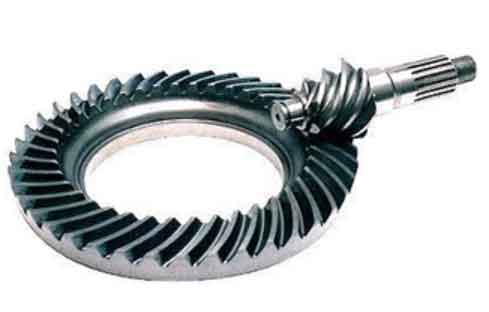Hypoid gears are commonly used in automotive differentials to transfer power and distribute torque in vehicles. Differentials are an essential component of the drivetrain that allows the wheels on the same axle to rotate at different speeds while receiving power from the engine.
Here’s how power transfer and torque distribution work in automotive differentials with hypoid gears:

- Power Transfer: The power from the engine is transmitted to the differential through the driveshaft. The driveshaft is connected to the pinion gear, which meshes with the ring gear in the differential housing.
- Hypoid Gear Design: Hypoid gears are a type of spiral bevel gears. They have a special design where the axes of the pinion gear and the ring gear are offset from each other. This offset allows the gears to be placed lower in the differential housing, creating space for the driveshaft to pass through.
- Torque Distribution: As the engine power is transmitted through the pinion gear, it engages with the ring gear, which is connected to the differential carrier. The differential carrier splits the torque and distributes it to the two output shafts, which connect to the wheels.
- Torque Split: In a typical open differential, the torque is split equally between the two wheels. This means that if one wheel encounters less traction or slips, the power is primarily directed to that wheel, resulting in a loss of traction. This is why open differentials are not ideal for off-road or high-performance applications.
- Limited-Slip and Locking Differentials: To improve traction and torque distribution, many vehicles employ limited-slip differentials or locking differentials. These systems use various mechanisms to distribute torque between the wheels based on factors such as wheel slip, vehicle speed, and driving conditions.
- Limited-Slip Differentials: Limited-slip differentials use friction plates or clutch packs to control torque distribution. When one wheel starts to slip, the differential sends more torque to the wheel with better traction. This helps to maximize traction and stability, especially in slippery or uneven conditions.
- Locking Differentials: Locking differentials, as the name suggests, lock the two output shafts together, ensuring equal torque distribution to both wheels. They provide maximum traction in off-road situations but may limit maneuverability on high-traction surfaces or during cornering.
Hypoid gears in automotive differentials play a crucial role in power transfer and torque distribution, allowing the wheels on the same axle to rotate at different speeds while effectively delivering power to the wheels with better traction. The use of limited-slip or locking differentials further enhances traction and vehicle performance in various driving conditions.
